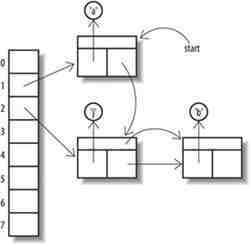Queues
A queue is a collection that implements
the interface java.util.Queue , usually a queue is an ordered
collection that follows the FIFO (First-In, First-Out) rule, but the
queue implementations allow other ways to order the collection as
well, such as LIFO or based on priority and so on.
The Queue interface defines the
following methods:
boolean add(E e): Inserts the
specified element into this queue if it is possible to do so
immediately without violating capacity restrictions, returning true
upon success and throwing an IllegalStateException if no space is
currently available.
E element(): Retrieves, but does
not remove, the head of this queue.
Boolean offer(E e): Inserts the
specified element into this queue if it is possible to do so
immediately without violating capacity restrictions.
E peek(): Retrieves, but does
not remove, the head of this queue, or returns null if this queue is
empty.
E poll(): Retrieves and removes
the head of this queue, or returns null if this queue is empty.
E remove(): Retrieves and
removes the head of this queue.
Whatever the ordering used, the head of
the queue is that element which would be removed by a call to
remove() or poll(). In a FIFO queue, all new elements are inserted at
the tail of the queue. Other kinds of queues may use different
placement rules. Every Queue implementation must specify its ordering
properties.
PriorityQueue
The class java.util.PriotiyQueue
is an implementation of the Queue interface, it is an ordered
collection and allows duplicates, it works as a “Priority-In,
Priority-Out” collection, its elements are ordered by priority and
its default priority is given by its natural order, it can be defined
another priority order with an instance of a Comparator.
Example
The previous example should print the
elements in the collection according to its priority, in this case it
should print 1 2 3 4 5 6 7 8 9, this means they priority is the
natural order.
To specify a different priority an
instance of a Comparator should be used:
Example
The previous example should print its
elements according to the new priority specified at the time the
collection was created, this new priority is the inverse of the
natural order and the example should print 9 8 7 6 5 4 3 2 1
Deque
The java.util.Deque interface
extends the Queue interface, the deque name means “double-ended
queue”. In a double-ended queue elements can be inserted and
removed at both ends of the queue, unlike queue that elements only
can be inserted at the tail and removed at the head.
With this a deque can also act as a
LIFO collection or Stack.
The Deque interface defines new methods
besides the ones defined in the Queue interface:
void addFirst(E e) : Inserts e
at the head if there is enough space
void addLast(E e): Inserts e at
the tail if there is enough space
void push(E e): Inserts e at the
head if there is enough space
boolean removeFirstOccurrence(Object
o): Removes the first occurrence of o
boolean removeLastOccurrence(Object
o): Removes the last occurrence of o
Iterator<E> descendingIterator():
Gets an iterator that returns the elements in reverse order
boolean offerFirst(E e): Inserts
e at the head if the deque has space
boolean offerLast(E e): Inserts
e at the tail if the deque has space
E peekFirst(): Gets but do not
removes the first element
E peekLast(): Gets but do not
removes the last element
E pollFirst(): Gets and removes
the first element
E pollLast(): Gets and removes
the last element
E getFirst(): Gets but do not
removes the first element
E getLast(): Gets but do not
removes the last element
E removeFirst(): Gets and
removes the first element
E removeLast(): Gets and removes
the last element
E pop(): Gets and removes the
first element
Example
In the previous example a deque
collection was created and elements were added in different ways,
first the elements were added at the head so the collection final
order was:
[9, 8, 7, 6, 5, 4, 3, 2, 1, 0]
The the elements were added to the tail
the collection final order was:
[0, 1, 2, 3, 4, 5, 6, 7, 8, 9]
And this is also the default behavior
for adding elements, in the example were used methods for querying
the head and the tail of the collection. The example should print:
[9, 8, 7, 6, 5, 4, 3, 2, 1, 0]
[0, 1, 2, 3, 4, 5, 6, 7, 8, 9]
[0, 1, 2, 3, 4, 5, 6, 7, 8, 9]
0
9
0
LinkedList
The class java.util.LinkedList
besides being a List also implements the Deque interface, this class
is very popular because with one class many different behaviors can
be implemented.





